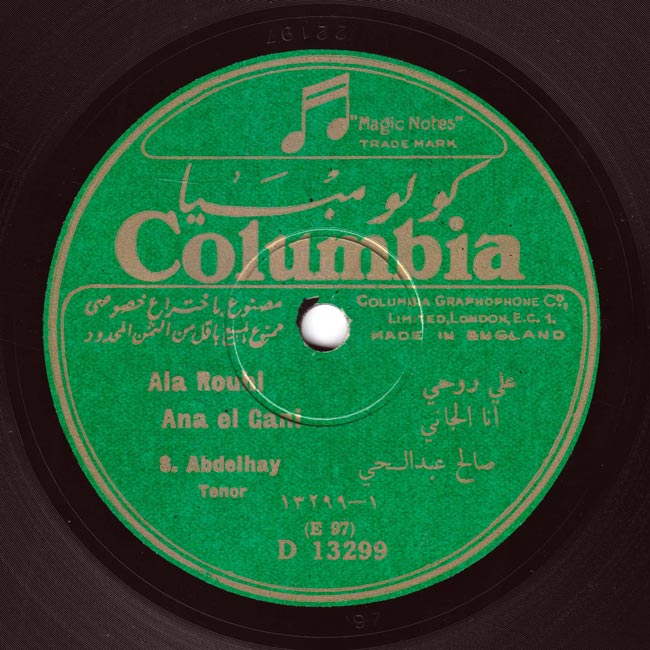Images
All images are courtesy of AMAR Foundation

search

All images are courtesy of AMAR Foundation

Munīra al-Mahdiyya (5)
The Arab Music Archiving and Research foundation (AMAR), in collaboration with the Sharjah Art Foundation (SAF), presents “Min al-Tārīkh”.
Dear listeners,
Welcome to a new episode of “Min al-Tārīkh”.
Today, we will resume our discussion about Sitt Munīra al-Mahdiyya with Prof. Frédéric Lagrange whom we will ask about the other types of ṭaqṭūqa. I do not think all ṭaqṭūqa are love ṭaqṭūqa, are they?
Their content is sometimes political or patriotic.
In 1922, exactly 2 years after the tomb of Tutankhamun was discovered in the Valley of the Kings in Luxor, Munīra al-Mahdiyya sang a ṭaqṭūqa to the maqām jahārkāh –also composed by Al-Qaṣṣabjī– “Mā ygibshi zayyī in laff el-kōn, dah iḥnā abūnā Tut‘ankhamūn”. Its political import is significant as it demonstrates that the political, patriotic, and ideological speech linking the Islamic history of Egypt to Pharaonic Egypt, had infiltrated the hearts of people who considered the pharaohs as their ancestors.
It is the speech of the Wafd party after the revolution of 1919.
Indeed, it is the wafdī speech…
…Opposed to the speech of the nationalist party… not the known nationalist party, but Muṣṭafa Kāmil’s nationalist party, i.e. the universal speech, not the Egyptian Nationalism speech.
Exactly…
(♩)
In relation to her wafdī leanings, or her support for nationalist issues, Munīra al-Mahdiyya sang “Shāl el-ḥamām ḥaṭṭ el-ḥamām” after Sa‘d Zaghlūl was exiled.
After his second exile, she sang “Shāl el-ḥamām ḥaṭṭ el-ḥamām”…
(♩)
But Munīra al-Mahdiyya sometimes lacked the necessary political wisdom: at the death of Sa‘d Zaghlūl in September 1927, posters were distributed in Cairo announcing that she was going to sing his elegy. On the evening of the event, she shocked the audience by singing ṭaqṭūqa “Yā balaḥ Zaghlūl”. That same year, débutante Umm Kulthūm sang Aḥmad Rāmī’s qaṣīda “In yaghib ‘an Miṣr Sa‘d”.
Yes.
Munīra al-Mahdiyya sometimes lacked the artistic wisdom. She did reach the top…
…But was not able to remain there.
Indeed. She was quasi-forgotten in the mid-1930s then completely forgotten in the 1940s.
In fact, her attempt to go back to the stage in May 1948 was a resounding failure. It is said that Umm Kulthūm attended the concert –not to gloat at Munīra al-Mahdiyya’s failure– and described the disharmony between Munīra al-Mahdiyya’s voice and the instrumentalists’ performance. Still, she went to congratulate her.
After that, Munīra al-Mahdiyya returned to the pontoon she was living on since the 1920s, made the pilgrimage to Mecca seven times, then died in 1965.
I think that the 1948 concert was a bad decision resulting from very poor artistic wisdom. Munīra al-Mahdiyya, who was unable to stay at the top, unwisely chose May 1948 when the efforts of Egypt’s government, people, and army were all fully engaged in the Palestine war… Her timing was blatantly inappropriate.
Very bad timing indeed.
Especially that the Palestine war was expected and did not come as a surprise. I do not think Munīra al-Mahdiyya had forgotten about that.
The last catalogue she appeared in, or the last new work she performed, was in the early 1930s, 1930-31… and thus I do not believe that the movie was made in 1935: if it had been made then, there would have been, at least, one or two soundtrack discs, which was not the case. So it can’t have been made in 1935.
The other notable fact is that Munīra al-Mahdiyya did not appear in the shows of the Egyptian Radio in the 1930s.
She did not appear in the shows of the Egyptian Radio… Yet there is a 7 minutes’ interview with her in Ḥusayn Riyāḍ’s show where he talked about year 1921 and where she sang “Ṣabḥa al-zibda” a cappella.
Wow…
There was also a 2-hour’ show dedicated to her, during her lifetime, made by the Egyptian Radio in the mid-1950s, followed by a short television interview in 1961.
Among her last recordings, out of her 1931 recordings, what is the most beautiful piece she sang?
They are all beautiful. But I prefer the marvellous “El-gafā ba‘d el-wafā”.
So let us listen to “El-gafā ba‘d el-wafā”…
(♩)
Did Munīra al-Mahdiyya officially announce the end of her artistic career, or not?
I do not think she did. The least well-documented period in the life of Munīra al-Mahdiyya goes from the mid-1930s to her 1948 concert.
Let us conclude our discussion with a recording that is a credit to the voice of Munīra al-Mahdiyya… Munīra al-Ḥijāziyya.
Salāma Ḥijāzī!
Salāma Ḥijāzī’s “Samaḥat bi-irsāl al-dumū‘ maḥājirī”
‘Ala al-waḥda!
‘Ala al-waḥda…
(♩)
So Munīra al-Mahdiyya died almost in silence in 1965.
Dear listeners, we have reached the end of today’s episode and the end of our discussion about Sitt Munīra al-Mahdiyya.
We thank Prof. Frédéric Lagrange.
We will meet again in a new episode of “Min al-Tārīkh”.
Thank you Sir for your generous presence.
Good day to you!
“Min al-Tārīkh” is brought to you by Mustafa Said.